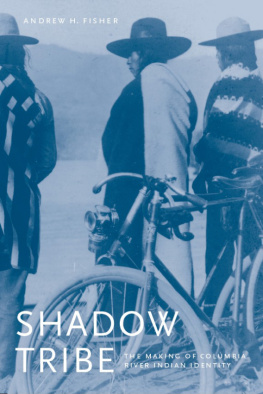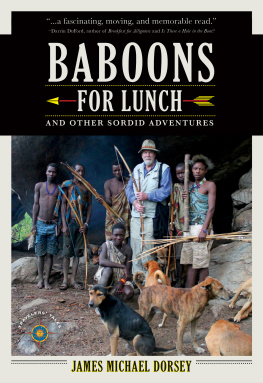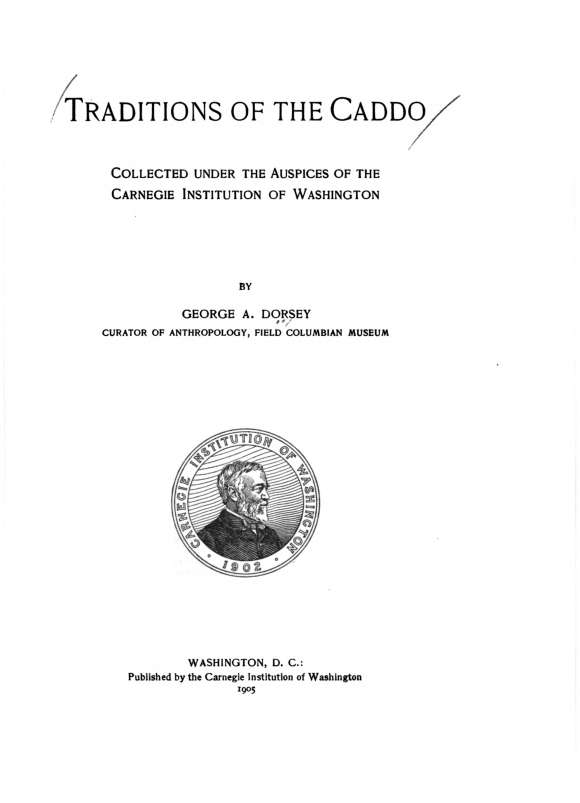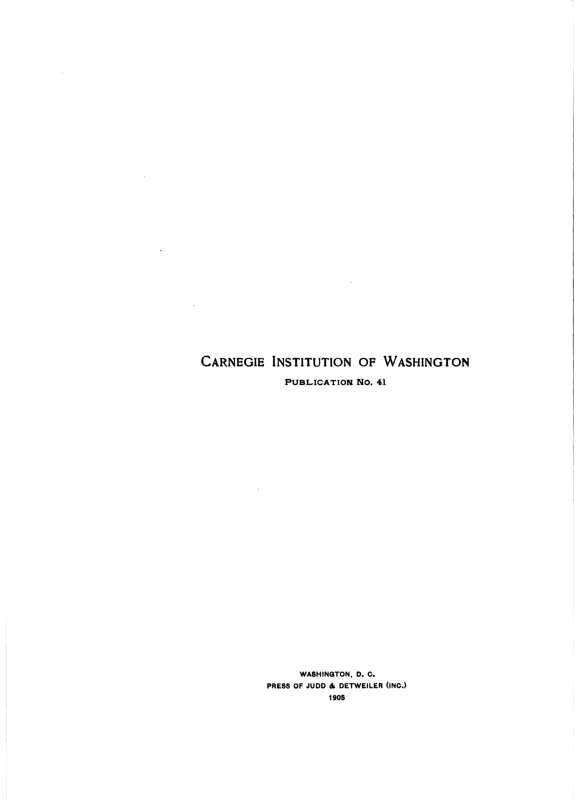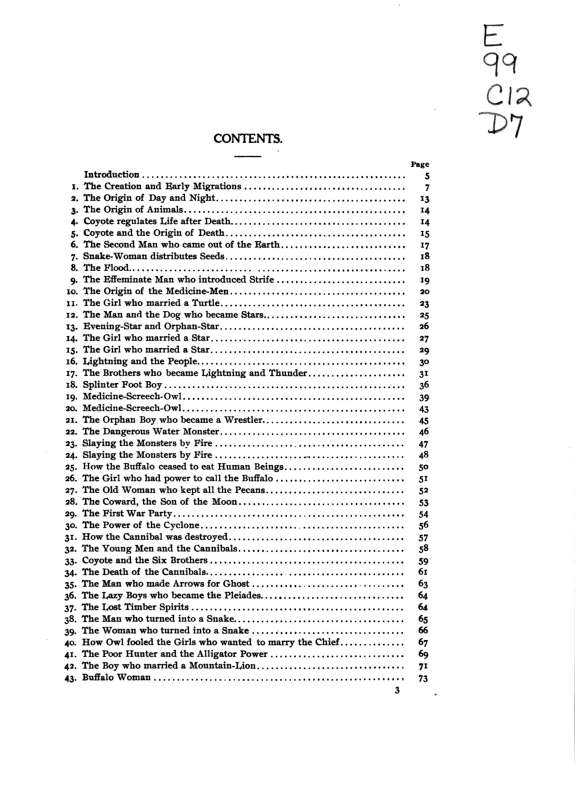Traditions of the Caddo
George Amos Dorsey
Google Book Search
This is a digital copy of a book that was preserved for generations on library shelves before it was carefully scanned by Google as part of a project to make the world's books discoverable online. See the back of the book for detailed information.
INTRODUCTION.
"PHE Caddo tales here presented were collected during the years * 1903-1905, under the auspices of the Carnegie Institution of Washington, and form part of a systematic investigation of the religious system and ceremonial organization of the tribes of the Caddoan stock.
The Caddo, numbering 530 in 1903, are of Caddoan stock, and since 1859 have lived in western Oklahoma between the Washita and Canadian rivers, where they have been closely associated with the Wichita. They retain practically nothing of their ancient culture. Their early home was in Louisiana, on the lower Red River. Later they migrated toward the Texas border, and still later to Brazos River in Texas. They met the whites as early as 1540, and throughout their history have maintained a friendly attitude toward the whites. Like the Wichita, their early habitations were conical grass lodges, and they were agriculturists, hunting the buffalo only within comparatively recent times.
The comparison of the Caddo tales with those of other tribes is deferred until the completion of the present investigation.
George A. Dorsey.
Chicago, July 31, 1905.
s
TRADITIONS OF THE CADDO.
I. THE CREATION AND EARLY MIGRATIONS.*
In the beginning the sun, stars, moon, and earth did not exist as they are now. Darkness ruled. With the lapse of time came a man, the only living being. Soon after his arrival a village sprang into existence with many thousands of people, and the people noticed that the man seemed to be everywhere. For a time he disappeared, and when he came back he had all kinds of seeds. He called all the people together and told them that the seeds were for them to eat, and gave them to every one. He told them that soon Darkness would go, and the people would see, for Darkness had promised that they should have a man by the name of Sun, and that he should be given power by the Great-Fat her-Above; that whenever his time should come to give them to the Sun he should be called or taken away from his mother, from our great mother Earth below; that the direction where the Sun should come from should be called "east," and the way of its going down should be called "west." He also announced to the people that he was the first being created and that he had been given power by the same Great-Father-Above, and that he had to carry out his work. He then told the people that it was very necessary that they should have one man abler and wiser than any other man among them, to be their head man ; that they should call him '' chief ;'' that whatever the chief should command should be done by the people; that they should look upon him as a great father. The unknown man told the people to return to their homes, hold a council among themselves, and select a chief.
When they had returned and assembled there was in the council a man by the name of Coyote, who told the people that the unknown powerful man should be called Moon, because he was the first man created on earth. The people decided that the Moon should be their head man or chief. Finally the Moon called the people together again and asked them if they had selected their head man or chief. Coyote told him that they had decided that he should be their head man, and that they had named him " Moon." After Moon came to be chief he selected another man, whom he called the Errand-Man, to be his helper, and to go around among the people to call them together whenever he might want them.
*Told by White-Bread.
One time the errand-man was sent out to tell the people that the chief wanted them to assemble; that he had very important news to tell them, and that they should come as quickly as they could. When they had come together the chief told them that they would all have to move away from the world that they were living in to another and better world; that he was going to lead them through, for he knew the way. The village which they were going to leave was called Old- Home-in-the-Darkness. Before the people were ready to leave, the chief sent the errand-man around among them to tell them that they were to be divided into groups, because there were so many of them ; that each group must have a leader, and he would give each leader a drum. The people began to form in groups and select their leaders. After the groups were all formed and each selected their leader, the chief called all the leaders together and gave each a drum, and then they were ready to start. The chief told all the leaders that they must sing and beat their drums as they were moving along ; that none of them should ever look back the way they came, lest the people should be stopped and have to stay where they werein darkness.
The people began moving westward, and they came out of the ground to another world. While they were yet coming out Coyote happened to be out. He began to look around, then told the chief that the world was too small for the people ; then he turned around and looked back in the direction from which they had come. The people had not all come out, and so half of them went back, but the others kept on going westward. Finally the chief picked up some dirt and threw it in front of him and formed very high mountains. When the people came to the mountains they stopped and began to make their first homes and villages. Moon went to the top of the mountain and looked about and found that the people had not all come the way he had come, but had scattered and gone in different directions. At the time when the people were all together they spoke but one language, the Caddo ; but after they had scattered out in groups each group spoke a different language. For this reason the many tribes of the present time speak different languages. When Moon came to his people, the few he had left, he told them the name of the place in the ground from which they had come. He told them that the direction to their right-hand side should be called north, or cold side, and^the direction to their left-hand side should be called south, or warm side. While Moon was talking the Sun came up out of the east, passed them, and went down in the west. He went too fast to do them any good at all. Coyote announced that he was going to stop the Sun from going so fast. He started eastward early in the morning, and when he came to a good place to stop he waited for the Sun to come up. When the Sun came up he found Coyote waiting for him. Coyote told the Sun that he had come there for the purpose of seeing him; that he wanted to talk with him, for he was in trouble. The Sun said that he had not very much time to stop and talk. Coyote told the Sun that he would go with him and talk to him as they went along. They started on, walking very slowly. Coyote kept telling about things that had lately happened. When the Sun was nearing the west Coyote told him that he was going to defecate, and asked him to wait a while. He started out behind the bushes, and just as soon as he was behind them, where the Sun could not see him, he ran away from the Sun and the Sun stood there waiting for him to return. After a while the Sun grew tired of waiting and started on very slowly, looking back every little while and watching for Coyote to catch up with him, but Coyote did not appear. The Sun went down very slowly, still waiting for Coyote. This is the reason that the Sun lingers and goes down very slowly.


